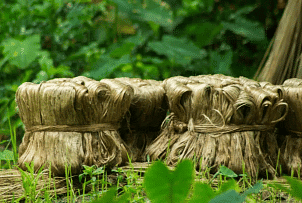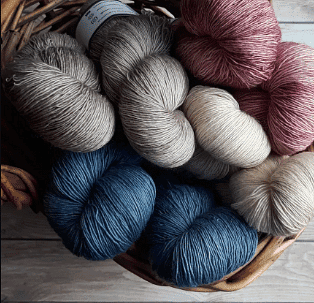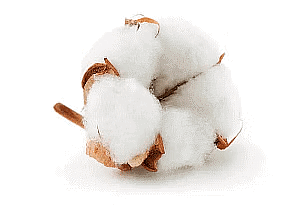Class 6 Exam > Class 6 Notes > Olympiad Notes: Fibre to Fabric
Olympiad Notes: Fibre to Fabric - Class 6 PDF Download
| Table of contents |

|
| Introduction |

|
| History of Clothing Material |

|
| Fibres Yarn and Fabric |

|
| Types of Fibres |

|
| Cotton |

|
| Jute |

|
| Fibre to Yarn : Spinning |

|
| Yarn to Fabric: Weaving and Knitting |

|
Introduction
- Clothing materials offer diverse textures, such as soft, coarse, or silky, resulting in varying sensations when worn.
- Different attires are suited for distinct seasons, adapting to weather changes and comfort needs.
- Clothes serve a protective function by shielding us from weather conditions and insect bites while also enhancing our appearance and presenting a smart outlook.
- Exploring the production process of various clothing types unveils insights into their creation and diverse characteristics.
History of Clothing Material
- In ancient times, individuals utilized large leaves from trees, tree barks, and animal skins as clothing.
- Early settlements witnessed the use of tied-together twigs, grass, leaves, and animal skins/furs fashioned into mats and draped as garments due to a lack of stitching knowledge.
- The absence of needles meant people relied on draping these materials over their bodies until the invention of the needle.
- The introduction of the needle facilitated the transformation of fabric into various shapes tailored to fit the body, marking the evolution of clothing.
- Contemporary clothing options for both men and women encompass a wide array of choices, including diverse colors, designs, and styles, marking a shift from simple attire to fashionable clothing.
Fibres Yarn and Fabric
- Fabric constitutes the materials or cloths we utilize, such as Cotton, Jute, Wool, Silk, Nylon, and Polyester. These fabrics are comprised of fine threads known as yarns.
- When a yarn is unraveled or loosened, it reveals numerous thin hair-like strands referred to as fibers.
- Thus, the structure of fabric comprises yarns, while yarns, in turn, consist of fibers, illustrating the hierarchical composition of these textile materials.
Types of Fibres
- Fibers are primarily categorized into two types: Natural Fibers and Synthetic Fibers.
- Natural Fibers are derived from plants or animals, showcasing materials such as Cotton and Jute obtained from plants, Wool sourced from the fleece of sheep or goats, and Silk procured from the cocoons of silkworms.
- Synthetic Fibers, on the other hand, are manufactured from chemical substances, distinct from sources found in plants or animals, exemplified by Polyester, Nylon, and Acrylic.
Cotton
- Cotton cultivation thrives in warm regions with black soil, commonly found in areas like Punjab, Haryana, Gujarat, and Rajasthan in India.
- The cotton plant bears fruits known as Cotton bolls, which burst open upon maturation, revealing seeds enveloped in cotton fibers.
- Harvesting involves handpicking cotton from these bolls.
- Through the process of Ginning, fibers are separated from the seeds in preparation for use.
- Cotton finds diverse applications in the production of sarees, shirts, pants, casual wear, bedsheets, curtains, and various other textile products.
Jute

- Jute is sourced from the stem of the jute plant, primarily cultivated in regions like West Bengal, Bihar, and Assam in India.
- Harvesting occurs when the jute plant reaches its flowering phase.
- After harvesting, the stems are soaked in water for a few days to facilitate the rotting process.
- Hand separation of fibers from the stem follows this rotting stage.
- These fibers are subsequently spun into yarns and utilized in the production of fabrics and other jute-based materials.
Fibre to Yarn : Spinning
- The conversion of fibers into yarn is known as Spinning.
- This process involves gently drawing out numerous fibers from materials like cotton or wool and carefully twisting them to create a cohesive yarn.
- Traditional devices such as takli, Charaka, as well as modern-day machines, are utilized in this spinning process.
- Charaka, popularized by Mahatma Gandhi, was a spinning wheel aimed at encouraging the domestic production of handwoven Indian cloth.
- Yarns produced through spinning are subsequently used in the manufacturing of fabrics and other textile products.
Yarn to Fabric: Weaving and Knitting
- Yarn obtained from spinning is typically transformed into fabric through weaving or knitting techniques.
- Weaving involves the arrangement of two or more yarns to create a fabric.
- Looms, either hand-operated (handloom) or power-operated, are used in the weaving process, as depicted in the figure.
- Knitting, in contrast, is the process of forming a fabric by interlocking a single yarn.
- Primarily utilized in woolen wear production, knitting can be done manually or using machinery for increased efficiency.
FAQs on Olympiad Notes: Fibre to Fabric - Class 6
| 1. What is the history of clothing material? |  |
Ans. Clothing materials have been used by humans for thousands of years. In ancient times, people used natural materials such as animal skins, leaves, and bark to cover themselves. Over time, they began to use fibers from plants such as cotton and jute to weave fabrics. With the advancement of technology, synthetic materials like polyester and nylon were developed, leading to a wide range of clothing options available today.
| 2. What are the different types of fibers used in clothing? |  |
Ans. There are various types of fibers used in clothing production. Some common ones include:
- Cotton: It is a natural fiber obtained from the cotton plant. It is known for its softness, breathability, and comfort.
- Jute: It is a natural fiber derived from the jute plant. It is commonly used in making bags, ropes, and coarse fabrics.
- Polyester: It is a synthetic fiber made from petrochemicals. It is durable, wrinkle-resistant, and easy to care for.
- Nylon: It is also a synthetic fiber known for its strength, elasticity, and resistance to abrasion.
- Silk: It is a natural protein fiber produced by silkworms. It is highly valued for its smoothness, luster, and luxurious feel.
| 3. How is fiber converted into yarn? |  |
Ans. The process of converting fiber into yarn is called spinning. It involves the following steps:
- Opening and cleaning: The raw fibers are cleaned to remove impurities like dirt and seeds.
- Carding: The fibers are straightened and aligned using a machine called a carding machine.
- Drawing: The carded fibers are further straightened and blended together to form a continuous strand called a sliver.
- Roving: The sliver is then drawn out and twisted to form a thin strand called roving.
- Spinning: The roving is spun using a spinning machine, which twists the fibers together to form yarn.
| 4. How is yarn transformed into fabric? |  |
Ans. Yarn is transformed into fabric through the processes of weaving and knitting.
- Weaving: In weaving, two sets of yarns called warp yarns and weft yarns are interlaced at right angles to form a fabric. The warp yarns are attached to a loom and held under tension, while the weft yarns are inserted across the warp yarns using a shuttle or other means.
- Knitting: Knitting involves interlocking loops of yarn to create a fabric. It can be done by hand or by using knitting machines. The loops can be formed in different ways, resulting in various types of knitted fabrics such as jerseys, rib knits, and cable knits.
| 5. What are some commonly used clothing materials made from fibers? |  |
Ans. Some commonly used clothing materials made from fibers include:
- T-shirts: These are often made from cotton or cotton blend fibers, known for their softness and breathability.
- Denim: Denim fabric is commonly used in jeans and jackets. It is made from cotton fibers, known for their durability and strength.
- Silk sarees: Silk sarees are made from silk fibers, known for their luxurious feel and lustrous appearance.
- Polyester sportswear: Many sportswear items such as running shorts and jerseys are made from polyester fibers, known for their quick-drying and moisture-wicking properties.
- Wool sweaters: Wool fibers, obtained from sheep, are used to make warm and insulating sweaters.
Related Searches





















